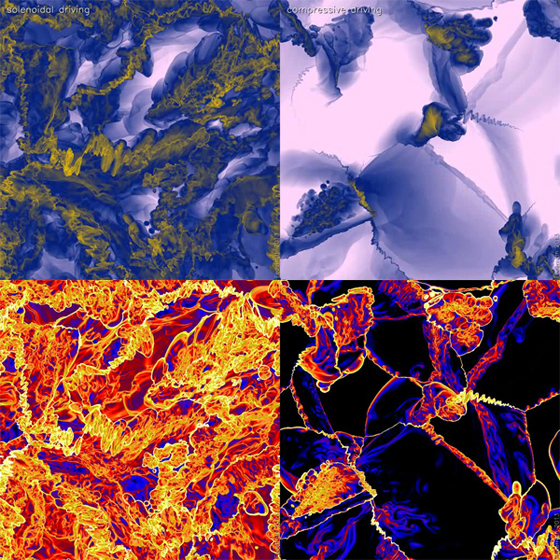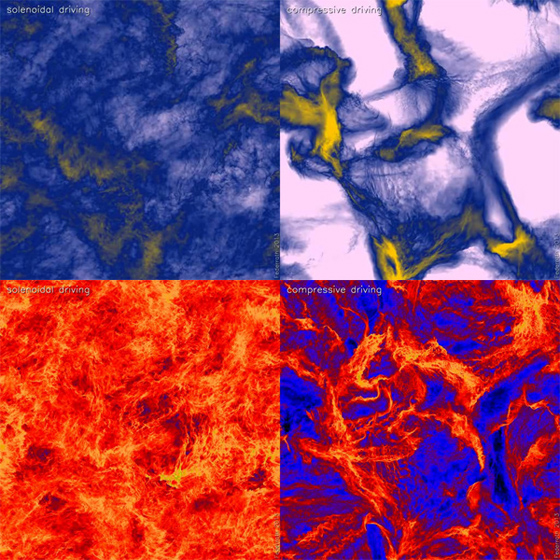ASTROPHYSICS
World's Largest Simulation of Supersonic, Compressible Turbulence
Principal Investigator:
Dr. Christoph Federrath
Affiliation:
Monash University, Clayton (Australia)
Local Project ID:
h1343
HPC Platform used:
SuperMUC of LRZ
Date published:
To advance the so far limited knowledge of density probability distribution function and the power spectrum of compressible, supersonic turbulence, a team of astrophysicists compared hydrodynamic models with numerical resolutions of 2563–40963 mesh points and with two distinct driving mechanisms, solenoidal (divergence-free) driving and compressive (curl-free) driving. By doing so, the scientists ran the world's largest simulation of supersonic turbulence on GCS supercomputers.
Compressible turbulence shapes the structure of the interstellar medium of our Galaxy and likely plays an important role also during structure formation in the early Universe. The density probability distribution function (PDF) and the power spectrum of such compressible, supersonic turbulence are the key ingredients for theories of star formation. However, both the PDF and the spectrum are still a matter of debate, because theoretical predictions are limited and simulations of supersonic turbulence require enormous resolutions to capture the inertial-range scaling. To advance our limited knowledge of compressible turbulence, scientists from the Institute of Theoretical Astrophysics of the University of Heidelberg and from the School of Mathematical Sciences of Monash University in Melbourne under leadership of Dr. Christoph Federrath present and analyse the world's largest simulations of supersonic turbulence, achieved on GCS HPC-System SuperMUC of Leibniz Supercomputing Centre. The astrophysicists compare hydrodynamic models with numerical resolutions of 2563–40963 mesh points and with two distinct driving mechanisms, solenoidal (divergence-free) driving and compressive (curl-free) driving. The scientists find convergence of the density PDF, with compressive driving exhibiting a much wider and more intermittent density distribution than solenoidal driving by fitting to a recent theoretical model for intermittent density PDFs. Analysing the power spectrum of the turbulence, the astrophysicists find a pure velocity scaling close to Burgers turbulence with P(v) ∝ k−2 for both driving modes in our hydrodynamical simulations with Mach number M=17. The spectrum of the density-weighted velocity ρ1/3v, however, does not provide the previously suggested universal scaling for supersonic turbulence. The scientists find that the power spectrum P(ρ1/3v) scales with wavenumber as k−1.74 for solenoidal driving, close to incompressible Kolmogorov turbulence (k−5/3), but is significantly steeper with k−2.10 for compressive driving, and they show that this is consistent with a recent theoretical model for compressible turbulence that predicts P(ρ1/3v) ∝ k−19/9 in the presence of a strong ∇⋅v component as is produced by compressive driving and remains remarkably constant throughout the supersonic turbulent cascade.

Figure 1: Slices through the three-dimensional gas density (top panels) and vorticity (bottom panels) for fully developed, highly compressible, supersonic turbulence, generated by solenoidal driving (left-hand column) and compressive driving (right-hand column), and a grid resolution of 40963cells.
Copyright: 2013 The Author Published by Oxford University Press on behalf of the Royal Astronomical Society
Figure 2: Same as Fig. 1, but instead of slices, these show projections (integration along the line of sight) of the three-dimensional gas density (top panels) and (mass-weighted) vorticity (bottom panels) for solenoidal driving (left-hand column) and compressive driving (right-hand column).
Copyright: 2013 The Author Published by Oxford University Press on behalf of the Royal Astronomical SocietyArticle in Monthly Notices of the Royal Astronomical Society (MNRAS) of Oxford Journals, 09/21/2013
Scientific Contact:
Dr. Christoph Federrath
School of Mathematical Sciences, Monash University
Clayton, Vic 3800, Australia
email: christoph.federrath@monash.edu
Project Website